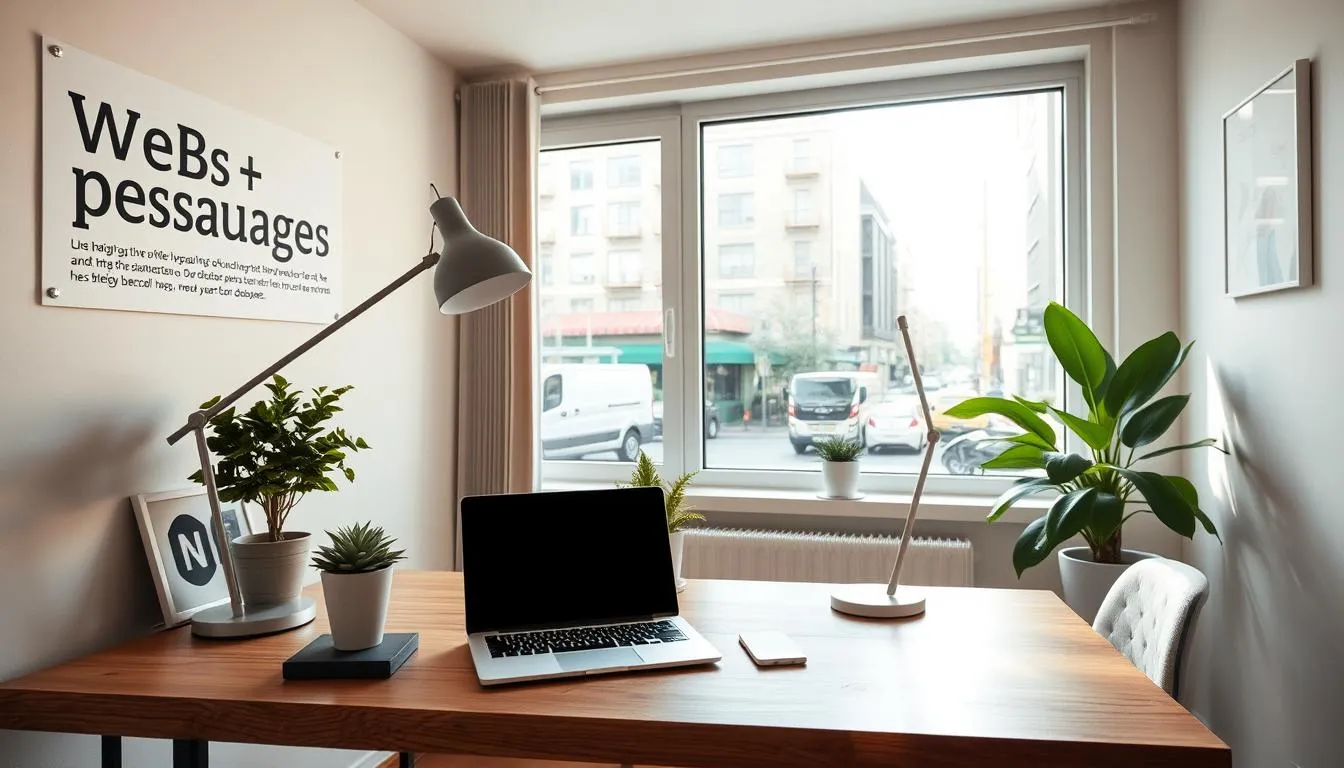Last Updated on: June 19, 2025
In today’s digital landscape, having a strong online presence is crucial for small businesses to thrive. A well-designed website serves as a digital storefront, making a great first impression on potential customers.
A professional web design not only enhances the credibility of your business but also improves user experience, driving engagement and conversions. By investing in effective web design, small businesses can level the playing field with larger companies, reaching a wider audience and expanding their customer base.
Key Takeaways
- A well-designed website is essential for small businesses to establish a strong online presence.
- Effective web design improves user experience, driving engagement and conversions.
- Investing in professional web design can help small businesses compete with larger companies.
- A strong online presence is crucial for small businesses to thrive in today’s digital landscape.
- Web design importance cannot be overstated for small businesses looking to expand their customer base.
The Digital Storefront: First Impressions Matter
Your website serves as the digital storefront for your business, making first impressions crucial. In the digital age, a well-designed website is not just a luxury, it’s a necessity for attracting and retaining customers.
A website that is visually appealing and easy to navigate can significantly enhance the user experience, encouraging visitors to explore your business further. Conversely, a poorly designed website can deter potential customers, leading to lost opportunities.
How Visitors Judge Your Business in Seconds
Visitors often form an opinion about your business within seconds of landing on your website. This initial judgment is based on the website’s design, layout, and overall aesthetic appeal. A professional and modern design can instill trust and credibility, while a cluttered or outdated site may raise doubts about your business’s reliability.
The Cost of Poor Design on Customer Trust
A poorly designed website can have a significant impact on customer trust, potentially leading to a loss of business. Research indicates that a substantial percentage of consumers will abandon a website if it’s not user-friendly or visually appealing. By investing in a well-designed website, you can foster trust and build a loyal customer base.
Why is Web Design Important for Small Businesses?
The importance of web design for small businesses cannot be overstated, as it plays a critical role in their online success. A well-designed website is essential for establishing a strong online presence, attracting potential customers, and driving business growth.
Competing with Larger Companies Online
Small businesses often find themselves competing with larger, more established companies online. A professional web design helps level the playing field, allowing small businesses to present themselves as credible and competitive. By investing in quality web design, small businesses can create a website that rivals those of larger companies, attracting customers who are searching for products or services online.
Converting Visitors into Customers
Effective web design is not just about aesthetics; it’s also about creating a user-friendly experience that encourages visitors to take action. A well-designed website guides visitors through the sales funnel, making it easier for them to convert into customers. This can be achieved through clear calls-to-action, intuitive navigation, and a responsive design that adapts to different devices.
Building Brand Identity and Recognition
A well-designed website is crucial for building and maintaining a strong brand identity. It provides an opportunity to showcase a brand’s personality, values, and mission. Consistent branding across the website and other marketing channels helps to build recognition and trust with potential customers, ultimately driving loyalty and advocacy.
Essential Elements of Effective Small Business Websites
An effective website is the backbone of any successful small business in today’s digital age. To create a website that truly supports business goals, several key elements must be considered.
Clear Navigation and Structure
A well-organized website with clear navigation is crucial for a positive user experience. Visitors should be able to find the information they need quickly and easily.
Compelling Call-to-Action Buttons
Call-to-action (CTA) buttons guide visitors through the website and encourage them to take specific actions. Effective CTAs are prominent, clear, and actionable.
Contact Information and Business Hours
Making contact information and business hours easily accessible is vital for customer engagement. This information should be displayed prominently on the website.
About Us and Testimonials Sections
The “About Us” section helps build a connection with customers by sharing the story behind the business. Testimonials from satisfied customers serve as social proof, enhancing credibility and trust.
By incorporating these essential elements, small businesses can create websites that are not only visually appealing but also effective in achieving their online goals.
Mobile-First Design: No Longer Optional
With the majority of internet users now accessing websites through mobile devices, a mobile-first design is no longer optional. This shift in consumer behavior has significant implications for businesses, particularly small businesses looking to establish a strong online presence.
The Mobile Shopping Revolution
The way people shop online has undergone a significant transformation with the rise of mobile devices. Mobile shopping has become increasingly popular, driven by the convenience and accessibility it offers.
Mobile Usage Statistics in America
In the United States, mobile devices account for a substantial portion of internet traffic. According to recent statistics, over 50% of internet users access the web primarily through their mobile devices. This trend is expected to continue, with mobile commerce projected to grow significantly in the coming years.
Mobile Conversion Rates
Businesses that optimize their websites for mobile devices often see higher conversion rates. A study found that mobile-optimized sites can increase conversion rates by up to 20%. This is because mobile-friendly websites provide a better user experience, making it easier for customers to navigate and complete transactions.
Google’s Mobile-First Indexing Explained
Google’s mobile-first indexing means that the search engine prioritizes the mobile version of a website when indexing and ranking. This change reflects the shift towards mobile internet usage and emphasizes the need for businesses to have a mobile-friendly website. To benefit from this, businesses should ensure their websites are responsive and provide a seamless user experience across all devices.
User Experience: The Heart of Effective Web Design
In the digital age, user experience has become the cornerstone of effective web design, directly influencing how visitors perceive and interact with a website.
A well-designed website is not just about looking good; it’s about creating an engaging and seamless experience for the user. This involves several key elements that work together to ensure a positive interaction.
Page Load Speed and Its Impact
One of the critical factors affecting user experience is page load speed. A slow-loading website can lead to frustration and a high bounce rate. Studies have shown that a delay of even a few seconds can significantly impact user engagement and conversion rates. Optimizing images, leveraging browser caching, and minimizing HTTP requests are some strategies to improve load times.
Intuitive Navigation Patterns
Intuitive navigation is another crucial aspect. Users should be able to find what they’re looking for quickly and easily. This involves creating a clear and consistent navigation structure, using familiar design patterns, and ensuring that the site is responsive across different devices.
Accessibility Considerations
Making a website accessible means ensuring that it can be used by everyone, including people with disabilities. This not only broadens your audience but also reflects positively on your brand.
ADA Compliance Basics
The Americans with Disabilities Act (ADA) requires that websites be accessible to individuals with disabilities. This includes providing alternative text for images, ensuring that navigation is possible using a keyboard, and making sure that the site is compatible with screen readers.
Inclusive Design Principles
Beyond compliance, adopting inclusive design principles can enhance the user experience for everyone. This involves designing with flexibility in mind, providing clear and consistent feedback, and testing with a diverse group of users.
Web Design and SEO: A Crucial Partnership
In the digital landscape, the synergy between web design and SEO is pivotal for online success. A well-crafted website that is both visually appealing and optimized for search engines can significantly enhance your online presence.
How Design Affects Search Rankings
The design of your website plays a crucial role in determining your search engine rankings. Search engines like Google favor websites that provide a good user experience, which includes factors like page load speed, mobile responsiveness, and intuitive navigation. A website that is difficult to navigate or slow to load can lead to higher bounce rates, negatively impacting your search rankings.
Structured Data and Technical SEO Elements
Beyond the visual aspects, technical SEO elements are vital for improving your website’s visibility on search engines. Structured data markup helps search engines understand the content and context of your webpage, enhancing your chances of appearing in rich snippets.
Schema Markup for Local Businesses
For local businesses, implementing schema markup can be particularly beneficial. It helps search engines understand your business hours, location, and other critical details, making it easier for customers to find you.
Image Optimization Techniques
Optimizing images on your website is another crucial aspect of technical SEO. Using descriptive alt tags and compressing images to reduce file size can improve page load times and enhance your website’s overall SEO.
Budget-Friendly Web Design Options for Small Businesses
Budget-friendly web design is now a reality for small businesses looking to thrive online. With various options available, businesses can choose the path that best suits their needs and budget.
Website Builders vs. Custom Development
When it comes to creating a website, small businesses are often faced with the decision between using website builders and opting for custom development. Website builders offer a quick, DIY solution with drag-and-drop tools and templates, making it easier for those without extensive technical knowledge to create a professional-looking site.
Popular Website Builder Platforms
Some popular website builder platforms include:
- Wix
- Squarespace
- Weebly
- Shopify
These platforms are user-friendly and offer a range of customizable templates. They also handle hosting and maintenance, making it a hassle-free experience for small business owners.
Custom Development Considerations
On the other hand, custom development offers a tailored solution that can be designed to meet the specific needs of a business. While it requires a larger upfront investment, custom development can provide a unique online presence that stands out from the competition.
Calculating ROI on Your Web Design Investment
Understanding the return on investment (ROI) of your web design is crucial. To calculate ROI, consider the costs of your web design against the benefits it brings, such as increased sales, improved brand recognition, and enhanced customer engagement.
For instance, if your web design costs $1,000 and it results in an additional $1,500 in sales, your ROI would be 50%. Tracking these metrics will help you understand the effectiveness of your web design investment.
DIY or Professional: Choosing the Right Approach
When it comes to creating a website for your small business, one of the most critical decisions you’ll make is whether to go the DIY route or hire a professional. Both options have their pros and cons, and the right choice for you depends on several factors, including your budget, technical expertise, and the complexity of your website needs.
When to Build Your Own Website
Building your own website can be a cost-effective solution if you have the time and willingness to learn. Website builders like Wix, Squarespace, and Weebly offer user-friendly platforms that can help you create a basic website without needing to know how to code. However, keep in mind that DIY websites may lack the customization and advanced features that a professional designer can provide.
When to Hire a Professional Designer
If you’re looking for a custom, professional-looking website that accurately represents your brand and meets your specific business needs, hiring a professional web designer is likely the better choice. Professionals can provide a more tailored solution, including advanced features and integrations that can enhance your online presence.
Questions to Ask Potential Web Designers
- What experience do you have with businesses like mine?
- Can you share examples of your previous work?
- How do you approach website design and development?
Red Flags to Watch For
- Unclear or unresponsive communication
- Unrealistic promises or guarantees
- Lack of transparency about costs or processes
Current Web Design Trends Small Businesses Should Consider
For small businesses, incorporating the latest web design trends can be the key to standing out in a crowded online marketplace. As technology advances and user behaviors evolve, staying current with these trends is not just about aesthetics; it’s about creating a seamless user experience that drives engagement.
Minimalist Design and White Space
One of the most enduring web design trends is minimalist design, characterized by the generous use of white space, simple typography, and a restrained color palette. This approach not only looks modern and sleek but also improves user navigation and focus on key content. Minimalist design helps in reducing clutter, making it easier for visitors to find what they’re looking for.
Video Backgrounds and Multimedia Elements
The use of video backgrounds and multimedia elements has become increasingly popular, adding an engaging layer to websites. Videos can effectively communicate a brand’s story, showcase products, or simply add aesthetic appeal. However, it’s crucial to use these elements judiciously to avoid slowing down page loads or distracting visitors.
Dark Mode and Accessibility Features
With the rise of dark mode, many websites now offer this feature, which can reduce eye strain and save battery life on OLED screens. Moreover, incorporating accessibility features is not just a trend but a necessity, ensuring that websites are usable by everyone, including people with disabilities. This includes clear navigation, readable font sizes, and proper color contrast.
By embracing these current web design trends, small businesses can enhance their online presence, improve user experience, and stay competitive in the digital landscape.
Local Business Success Stories: Web Design Case Studies
Through effective web design, local businesses have not only improved their online presence but also boosted their overall performance. This section highlights two compelling case studies that demonstrate the transformative power of web design.
Retail Store Transformation
A local retail store in the United States was struggling to attract customers to its physical location. By revamping its website with a mobile-friendly design and easy navigation, the store saw a significant increase in foot traffic. The new website featured high-quality product images and promotions that encouraged visitors to visit the store. As a result, the store experienced a 30% increase in sales within the first quarter.
Service Business Growth Through Design
A service-based business, offering consulting services, was able to expand its client base through a well-designed website. The website incorporated clear call-to-action buttons and testimonials from satisfied clients, which helped build trust with potential customers. By improving its online presence, the business was able to reach a wider audience and increase its revenue by 25% within six months.
These case studies illustrate the potential of effective web design to drive business success. By investing in a well-designed website, local businesses can improve their online visibility, attract more customers, and ultimately increase their revenue.
Implementing Your Web Design Strategy: Step by Step
Implementing a web design strategy can seem daunting, but breaking it down into manageable steps makes it achievable. By following a structured approach, small businesses can effectively create and launch their website, enhancing their online presence.
Planning Your Website Structure
A well-planned website structure is crucial for user experience and search engine optimization. It involves creating a clear hierarchy of pages and ensuring that visitors can easily navigate your site.
Sitemap Creation
Begin by creating a sitemap that outlines all the pages on your website. This visual representation helps in organizing content and planning the navigation.
Content Planning
Next, plan your content to ensure it aligns with your business goals and resonates with your target audience. This step is crucial for engaging visitors and driving conversions.
Content Creation and Collection
With your structure and content plan in place, it’s time to create and gather content. This includes writing text, sourcing images, and producing other media that will populate your website.
Launch and Promotion
Once your website is built and populated with content, it’s ready for launch. Post-launch, focus on promoting your site through various channels.
Social Media Integration
Integrate your website with social media platforms to expand your reach and engage with your audience on multiple fronts.
Local SEO Considerations
For businesses targeting a local audience, optimizing your website for local SEO is critical. This includes listing your business in local directories and using location-specific keywords.
Conclusion
A well-crafted web design is crucial for small businesses aiming to establish a strong online presence. As discussed throughout this article, a website is often the first point of contact between a business and its potential customers, making it essential to create a positive and lasting impression.
By incorporating essential elements such as clear navigation, compelling call-to-action buttons, and mobile-first design, small businesses can significantly enhance their online visibility and attract more customers. A user-friendly website not only improves customer experience but also contributes to a business’s overall brand identity and recognition.
The partnership between web design and SEO is vital in today’s digital landscape. A website that is both visually appealing and optimized for search engines can improve search rankings, driving more traffic to the site. As small businesses continue to navigate the online world, investing in a professional web design can yield a significant return on investment.
In conclusion, a thoughtful web design conclusion is not just about wrapping up the article; it’s about empowering small businesses with the knowledge to boost their online presence. By applying the principles outlined in this article, businesses can create a robust online foundation that supports their growth and success.
FAQ
What is the importance of having a website for small businesses?
Having a website is crucial for small businesses as it serves as a digital storefront, making a great first impression on potential customers and helping them compete with larger companies online.
How does web design impact customer trust?
Poor web design can negatively impact customer trust, while a well-designed website can help establish credibility and build trust with potential customers.
What are the essential elements of an effective small business website?
Essential elements include clear navigation and structure, compelling call-to-action buttons, easily accessible contact information, and “About Us” and testimonials sections.
Why is mobile-first design important for small businesses?
Mobile-first design is crucial as it caters to the growing number of mobile users, ensuring a smooth user experience and improving search engine rankings.
How does user experience impact web design?
User experience is critical in web design as it affects page load speed, intuitive navigation, and accessibility, ultimately influencing customer engagement and conversion.
What is the relationship between web design and SEO?
Web design and SEO are closely linked, as design elements can impact search rankings, and structured data and technical SEO elements can improve website visibility.
What are the budget-friendly web design options for small businesses?
Small businesses can consider website builders or custom development, depending on their needs and budget, and should calculate the ROI on their web design investment.
Should small businesses build their own website or hire a professional designer?
The decision to build a website or hire a professional designer depends on the business’s complexity, budget, and design requirements, and it’s essential to consider factors like expertise and time commitment.
What are the current web design trends that small businesses should consider?
Current trends include minimalist design, video backgrounds, dark mode, and accessibility features, which can enhance the user experience and improve website engagement.
How can small businesses implement their web design strategy effectively?
Small businesses should plan their website structure, create high-quality content, and launch their website with a solid promotion strategy, including social media integration and local SEO considerations.




